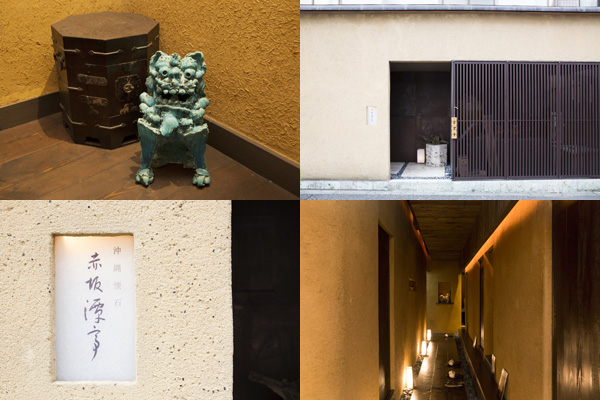Okinawan preserved foods: Traditional Japanese Preserved Food
Aug 07,2014
Okinawan preserved foods: Traditional Japanese Preserved Food
Aug 07,2014
Preserved food has been developed through the ages all around the world to prepare for seasons of chronic food scarcity and unforeseen situations, so as not waste precious food ingredients.
Fresh vegetables, fruit, fish, shellfish and meat are processed using techniques such as fermentation, drying and smoking. The culinary culture of a country or area lives in its preserved foods.
We are on a journey to explore preserved foods, wisdom for everyday life that support the foundations of culinary culture.
In Part 8, we visit the renowned Okinawan kaiseki restaurant Akasaka Tantei to learn about Okinawa’s preserved foods.

▶Tsukemono (Japanese pickles): A Traditional Japanese Preserved Food
▶Shopping Spot Murakara Machikara Kan: Discover Traditional Japanese Preserved Food

The Ryukyu Kingdom flourished for around 450 years from the beginning of the 15th century, building a unique culture along the way. Its food culture, too, had a special culinary tradition for entertaining sakuhotei (envoys) send by the emperors of Imperial China.
Akasaka Tantei is an Okinawan kaiseki (haute cuisine) restaurant that recreates this court cuisine using modern techniques. It has earned a Michelin star in three consecutive years.
“Court cuisine was wiped from history for a time at the end of the Edo period. Reading the literature of the time, we are bringing it back through trial and error,” says Head Chef Tanaka Naoki-san. It is a fresh challenge for Tanaka-san, who studied Washoku (Japanese cuisine).
“Where Washoku is a cuisine of subtraction, the Okinawan cuisine, I believe, is one of addition. Take sake (Japanese rice wine). In Washoku, we polish the rice down to the core to get rid of any unpleasant taste. In Okinawan cuisine, on the other hand, we combine various strongly flavored ingredients together to create depth of flavor, and balance the whole, for instance in the Okinawan stir-fried dish chanpuru. It’s a similar idea to that of French cuisine.”
A symbol of this is a dish combining andansū, or Okinawan miso and boned rib of Okinawan pork stir-fried in lard, with gōya (bitter gourd). Bitter gourd grown on Okinawa’s soils, which have poor drainage, are much darker in color and even more bitter than those grown on the mainland, but they are a brilliant match for Okinawan miso, which is less salty and has a sweetness to it.
Okinawan-style tofu topped with sukugarasu, or young mottled spinefoot pickled in salt, provides a contrast in bite and flavor.
“Blessed with a warm climate, Okinawa also has a rich variety of ingredients. However, since food spoils quickly after it is cooked, there are many recipes for preserving food by salting and fermenting it. If ever too much Okinawan-style tofu—something Okinawans adore—has been made and there is some left over, it will be washed with salted water and steamed, grilled or deep-fried to preserve it.”


Okinawan-style fermented tofu is one of the representative preserved foods of Okinawa.
At Akasaka Tantei, it is made by draining Okinawan-style tofu, cutting it into small squares, drying it for several days, washing it in Okinawa’s strong liquor, awamori, and steeping it for three to six months in kōji (malted rice), which has been fermented in awamori for this purpose. The vibrant red color comes from beni kōji (rice fermented with red yeast), which is added to the kōji. Sometimes called the “cheese of the East,” its flavor is, of course, rich and one bite will help several cups of drink go down.
Pork is another essential ingredient of Okinawan cooking. Since olden times, eating not only pork loin and boned rib (with skin), but also the pig’s head, trotters, tail, organ meats and skin, has been the norm. It’s said that Okinawans eat the whole pig, except the oink.
“Fresh pig’s blood is mixed with salt and katakuriko (dogtooth violet starch) and steamed to preserve it. Pig’s blood is a valuable seasoning. Pork fat (lard) is also essential to cooking. Not wasting a single part of the animal’s life is how it is done in Okinawa.”
Okinawa’s agū pork is famous as black pork whose fat is delicious and low in cholesterol. At Akasaka Tantei, almost all the ingredients, including agū pork, are produced in Okinawa.
Sūchika (salt-cured pork) is the perfect way to savor the charms of agū pork. Fresh uncooked boned rib is cured in salt for about five days, then steeped in water for a few hours before its eaten. The almost translucent fat is mild in flavor and the soft but perfectly matured meat is assertively meaty in flavor. It’s a match made in heaven.
While not as numerous as those for pork, there are many variations of gōya dishes. Bitter gourd cured in brown sugar is a dessert that keeps well. After drawing the moisture out of the gōya by curing it in salt, the gourd is marinated for a few days in brown sugar syrup. It’s a grown-up take on the sweet snack, with bitter and sweet working in harmony.
Chinsukō, a simple shortbread-like treat made only with flour, lard and sugar, is an Okinawan classic. Freshly baked, it is fragrant and flaky. It is a perfect accompaniment to afternoon tea.
Just sampling a few refreshing Okinawan preserved foods makes you want to jet off to Okinawa.
▶Tsukemono (Japanese pickles): A Traditional Japanese Preserved Food
▶Shopping Spot Murakara Machikara Kan: Discover Traditional Japanese Preserved Food